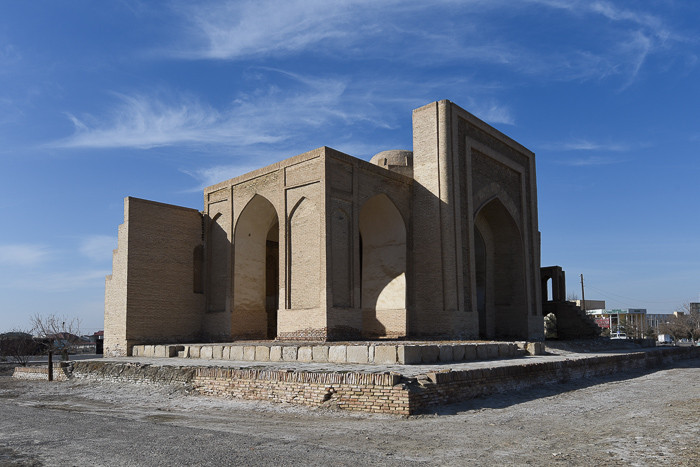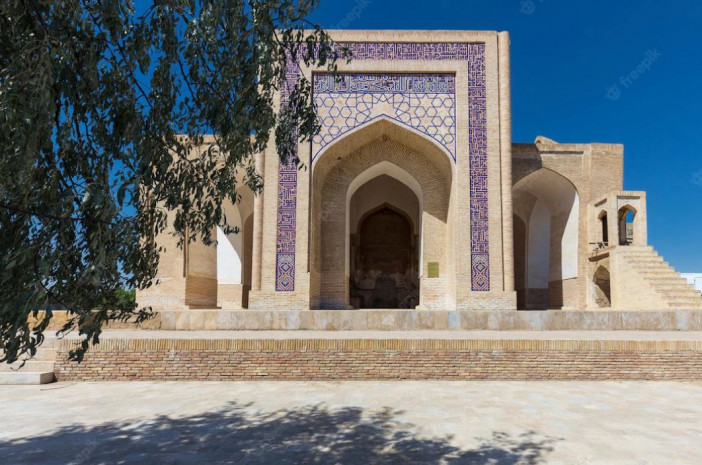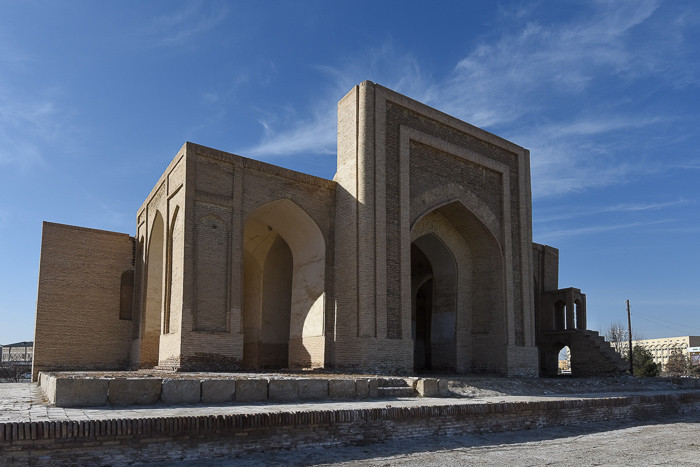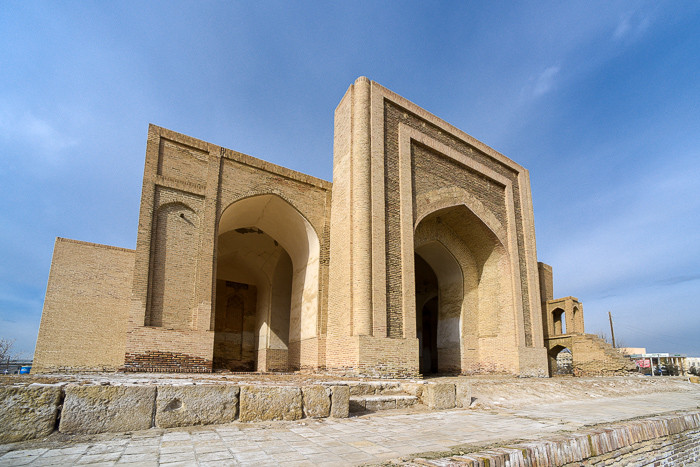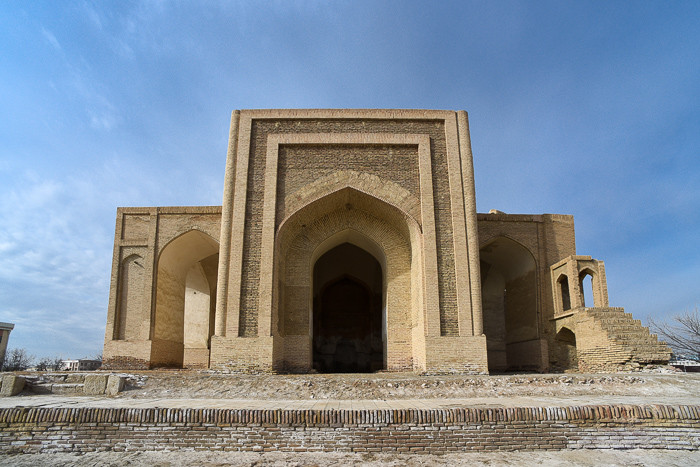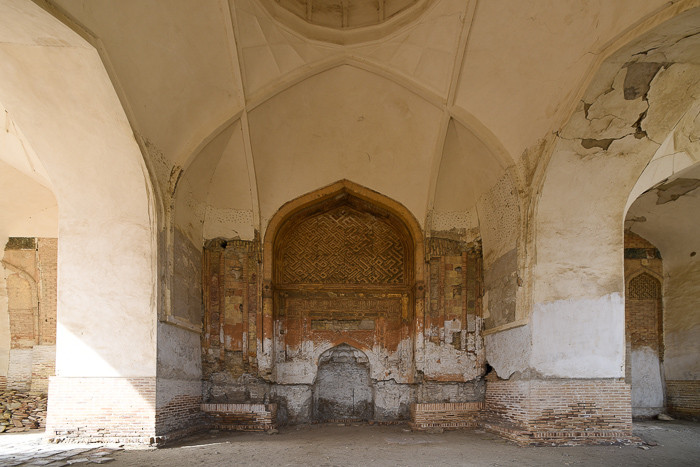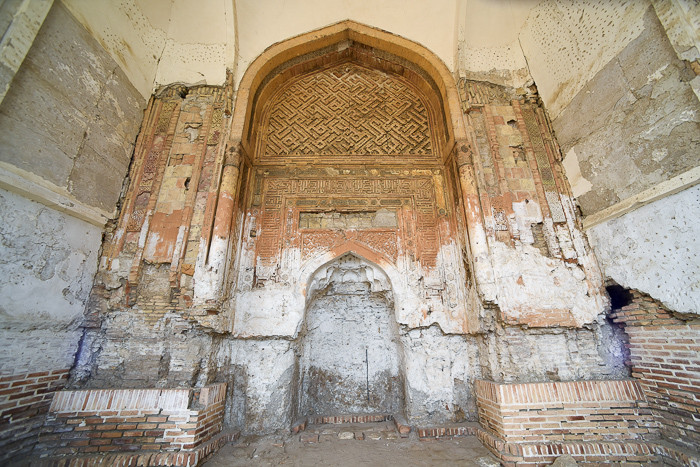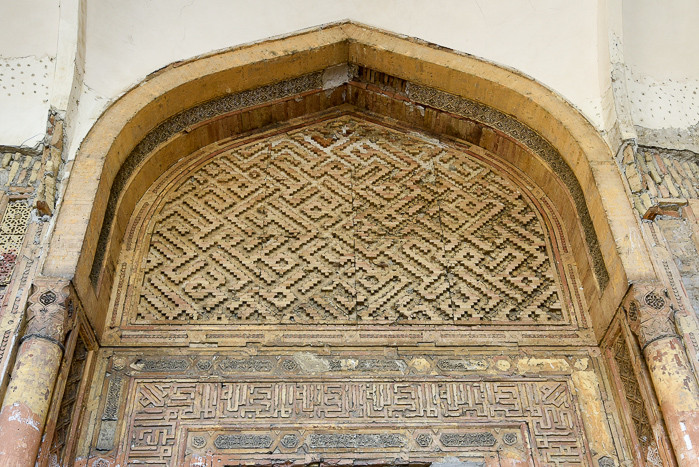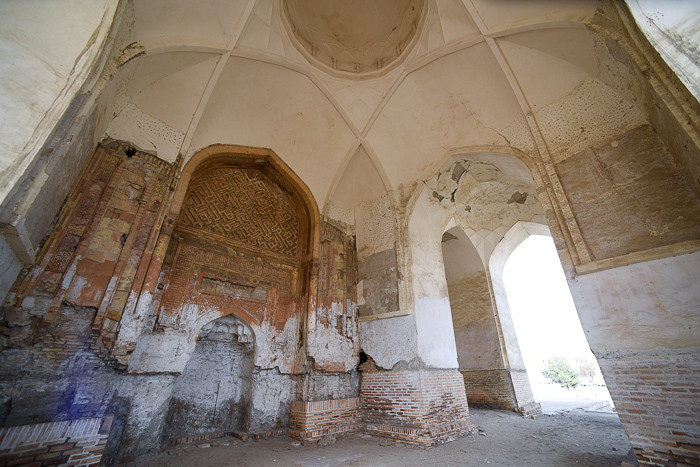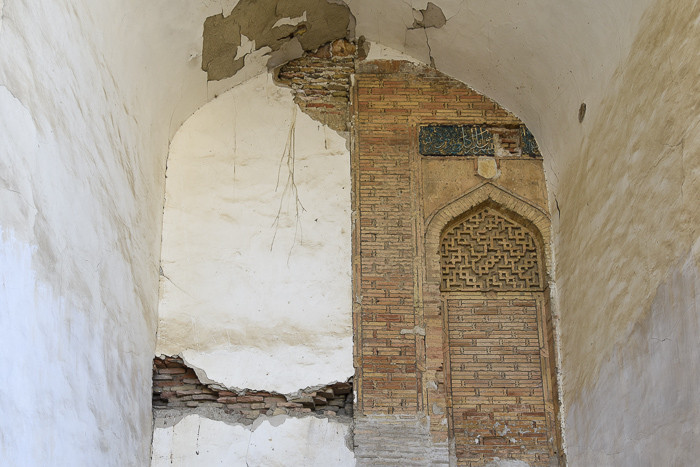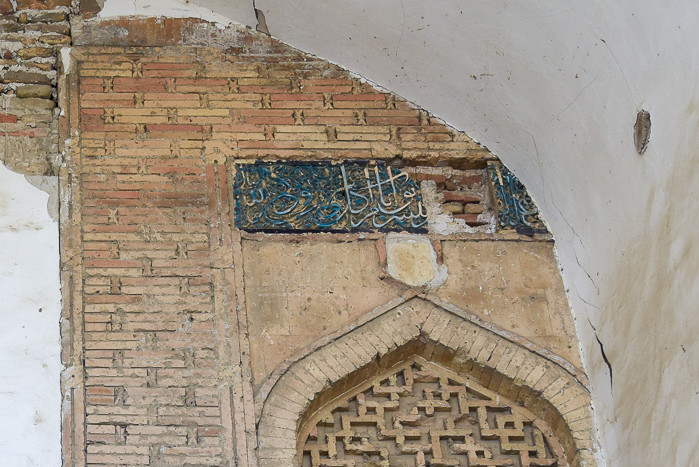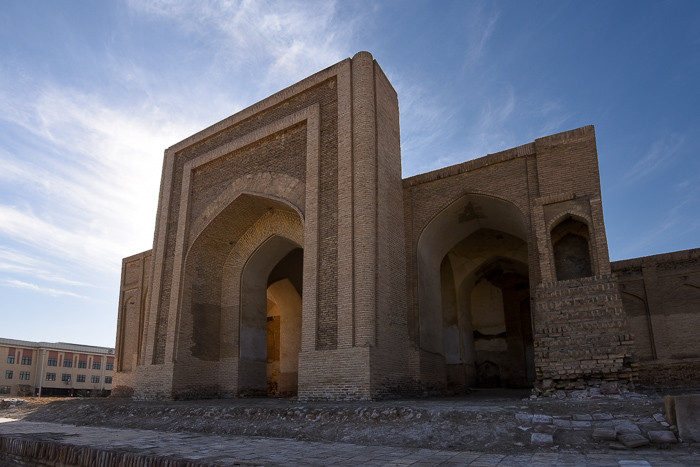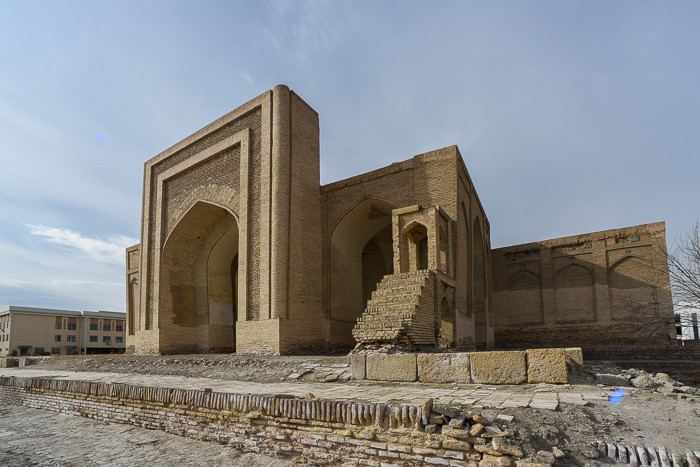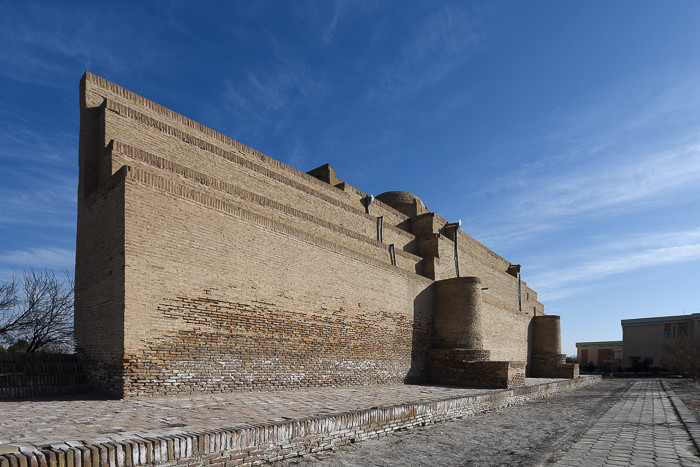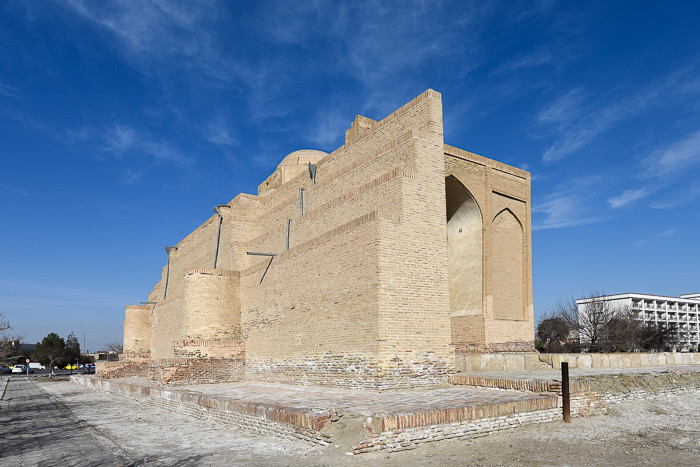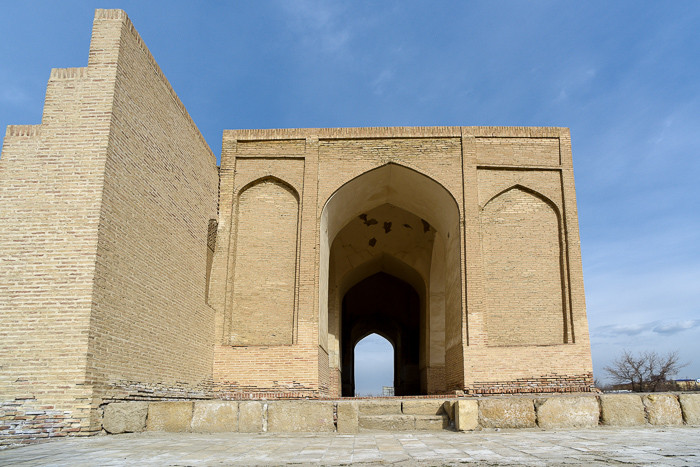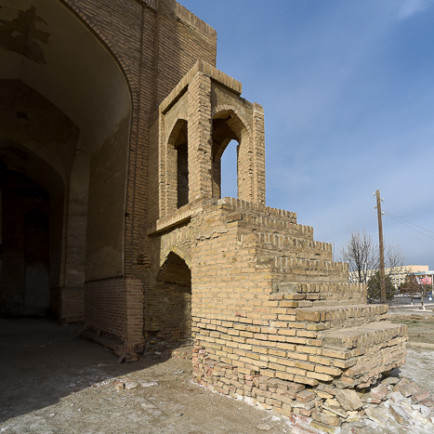Namazgah Mosque
History
Perhaps due to its location away from the city center, the mosque is one of only a handful of buildings that survive from prior to the Mongol era, with other notable examples being the Kalyan minaret, the Ismail Samani Mausoleum, and the much-refurbished Magok-i Attari mosque. When the mosque was first built it was intended to be used as what Knoblauch refers to as an “out of town mosque” where the city’s faithful could congregate several days a year for important feast days. As even the city’s Friday mosque was generally too small for this purpose, such “out of town” mosques were ideal as they faced large open fields with enough capacity for everyone to gather. As they were located far from the city center, such mosques were only occasionally used for special holidays such as the Eid Al-Fitr and Eid Al-Adha. The field in front of it was dotted with a handful of trees where people gathered to hear prayers read during the Ramadan and Kurban holidays. Between the city and the mosque, vendors set up temporary booths for the sale of candy, dried fruit, and other portable merchandise. He also noted the presence of other forms of entertainment such as wrestling matches, foot races, and camel fights.
Urban and Architectural
several fragments of glazed turquoise calligraphy that stand in the north arcade may date from the Mongol period; clearly they predate the addition of the arcades as the composition is clumsily interrupted by the arcade’s presence. If correct, these may be some of the earliest instances of glazed tiles in the Bukhara region apart from those on the Vobkent Minaret and Chashma Ayub, both north of the city. Apart from the glazed tiles, the exterior of the mosque no longer retains any ornament. The tympanum of the central mihrab does retain some high-quality square Kufic designs in high brick relief (resembling a maze) and other ornament, protected as they are from the elements.
Description
The Namazgah mosque stands on the south side of the city, about a kilometer south of the Namazgah gate that shares the same name. The word "Namazgah" simply means "Place of Prayer" in Persian. The monument was established from 1119-20 during the Karakhanid period as an open-air mosque comprising a long, low wall measuring 38 meters in length and a single mihrab niche indicating the direction of Mecca. In the Mongol era (beginning in the mid-13th century), glazed tiles and others decoration were added to the qibla side of the wall. The mosque was further remodeled in the 16th century with the addition of arcades that were awkwardly affixed to the existing structure. Currently the monument stands in partial ruin and is located well to the south of the areas frequented by tourists.
References
" Chuvin, Pierre and Gerard Degeorge. Samarkand, Bukhara, Khiva. Italy: Flammarion, 2001.
Dani, Ahmad H., et al. History of Civilizations of Central Asia. Paris: Unesco, 1992.
Gangler, Anette et. al. Bukhara: the Eastern Dome of Islam. City: Axel Menges, 2004.
Grabar, Oleg. “The Earliest Islamic Commemorative Structures, Notes and Documents.” Ars Orientalis, vol. 6, 1966, pp. 7–46. JSTOR, www.jstor.org/stable/4629220.
Hillenbrand, Robert. Islamic Architecture. New York: Columbia University Press, 1994.
Knobloch, Edgar. Monuments of Central Asia. London: I.B. Tauris: in the United States and Canada distributed by St. Martin's Press, 2001.
MacLeod, Calum, and Bradley Mayhew. Uzbekistan: the Golden Road to Samarkand. Hong Kong & New York: Odyssey Books & Maps. Distributed in the USA by W.W. Norton & Company, Inc, 2014.
Soustel, Jean & Porter, Yves. Tombs of Paradise: The Shah-e Zende in Samarkand and Architectural Ceramics of Central Asia. Hong Kong: Paul Holberton publishing, 2002.
"
Details
Location
QC66+MQV, Buxoro, Uzbekistan
Year of Build
(1119-20, modified 16th century)
Drawings
Map
History
Perhaps due to its location away from the city center, the mosque is one of only a handful of buildings that survive from prior to the Mongol era, with other notable examples being the Kalyan minaret, the Ismail Samani Mausoleum, and the much-refurbished Magok-i Attari mosque. When the mosque was first built it was intended to be used as what Knoblauch refers to as an “out of town mosque” where the city’s faithful could congregate several days a year for important feast days. As even the city’s Friday mosque was generally too small for this purpose, such “out of town” mosques were ideal as they faced large open fields with enough capacity for everyone to gather. As they were located far from the city center, such mosques were only occasionally used for special holidays such as the Eid Al-Fitr and Eid Al-Adha. The field in front of it was dotted with a handful of trees where people gathered to hear prayers read during the Ramadan and Kurban holidays. Between the city and the mosque, vendors set up temporary booths for the sale of candy, dried fruit, and other portable merchandise. He also noted the presence of other forms of entertainment such as wrestling matches, foot races, and camel fights.
Urban and Architectural
several fragments of glazed turquoise calligraphy that stand in the north arcade may date from the Mongol period; clearly they predate the addition of the arcades as the composition is clumsily interrupted by the arcade’s presence. If correct, these may be some of the earliest instances of glazed tiles in the Bukhara region apart from those on the Vobkent Minaret and Chashma Ayub, both north of the city. Apart from the glazed tiles, the exterior of the mosque no longer retains any ornament. The tympanum of the central mihrab does retain some high-quality square Kufic designs in high brick relief (resembling a maze) and other ornament, protected as they are from the elements.
Description
The Namazgah mosque stands on the south side of the city, about a kilometer south of the Namazgah gate that shares the same name. The word "Namazgah" simply means "Place of Prayer" in Persian. The monument was established from 1119-20 during the Karakhanid period as an open-air mosque comprising a long, low wall measuring 38 meters in length and a single mihrab niche indicating the direction of Mecca. In the Mongol era (beginning in the mid-13th century), glazed tiles and others decoration were added to the qibla side of the wall. The mosque was further remodeled in the 16th century with the addition of arcades that were awkwardly affixed to the existing structure. Currently the monument stands in partial ruin and is located well to the south of the areas frequented by tourists.


